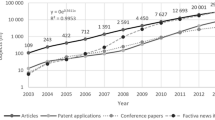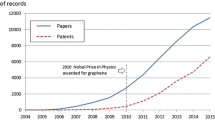Abstract
Graphene, a novel nanomaterial consisting of a single layer of carbon atoms, has attracted significant attention due to its distinctive properties, including great strength, electrical and thermal conductivity, lightness, and potential benefits for diverse applications. The commercialization of scientific discoveries such as graphene is inherently uncertain, with the lag time between the scientific development of a new technology and its adoption by corporate actors revealing the extent to which firms are able to absorb knowledge and engage in learning to implement applications based on the new technology. From this perspective, we test for the existence of three different corporate learning and activity patterns: (1) a linear process where patenting follows scientific discovery; (2) a double-boom phenomenon where corporate (patenting) activity is first concentrated in technological improvements and then followed by a period of technology productization; and (3) a concurrent model where scientific discovery in publications occurs in parallel with patenting. By analyzing corporate publication and patent activity across country and application lines, we find that, while graphene as a whole is experiencing concurrent scientific development and patenting growth, country- and application-specific trends offer some evidence of the linear and double-boom models.






Similar content being viewed by others
Notes
http://www.nano.gov/html/about/home_about.html, accessed April 15, 2011.
References
Abernathy W, Utterback J (1978) Patterns of industrial innovation. Technol Rev 80(7):40–47
Brouwer E, Kleinknecht A (1999) Innovative output, and a firm’s propensity to patent: an exploration of CIS micro data. Res Policy 28(6):615–624
Cockburn I, Henderson R, Stern S (1999) The Diffusion of science driven drug discovery: organizational change in pharmaceutical research. NBER Working Paper 7359. Cambridge, MA
Cohen SS, Di Minin A, Motoyama Y, Palmberg C (2009) The persistence of home bias for important r&d in wireless telecom and automobiles. Rev Policy Res 26(1/2):55–76. doi:10.1111/j.1541-1338.2008.00369.x
Cohen W, Levinthal D (1989) Absorptive capacity: a new perspective on learning and innovation. Adm Sci Q 35(1):128–152
Cohen, W, Nelson, R, and Walsh, J (2000) Protecting their intellectual assets: appropriability conditions and why U.S. manufacturing firms patent (or not). NBER Working Paper 7552, Cambridge, MA
Edquist C (ed) (1997) Systems of innovation. Technologies, institutions and organizations. Pinter Publisher, London, Washington
Grupp H (2000) Learning in a science-driven market: the case of lasers. Ind Corp Change 9(1):143–172
Helfat CE, Lieberman MB (2002) The birth of capabilities: market entry and the importance of pre-history. Ind Corp Change 11(4):725–760
Hobday M (2005) Firm-level innovation models: perspectives on research in developed and developing countries. Technol Anal Strat Manag 17(2):121–146
Hoppe H (2000) Second-mover advantages in the strategic adoption of new technology under uncertainty. Int J Ind Organ 18(2):315–338. doi:10.1016/S0167-7187(98)00020-4
Hoppe H (2002) The timing of new technology adoption: theoretical models and empirical evidence. Manch Sch 70(1):56–76. doi:10.1111/1467-9957.00283
ITRS (2010) International technology roadmap for semiconductors 2010 update overview. http://www.itrs.net/Links/2010ITRS/2010Update/ToPost/2010_Update_Overview.pdf,accessed. Accessed 14 April 2011
Katila R, Ahuja G (2002) Something old, something new: a longitudinal study of search behavior and new product introduction. Acad Manag J 456:1183–1194
Kogut B, Kulatilaka N (2001) Capabilities as real options. Org Sci 12(6):744–758
Lavie D, Stettner U, Tushman ML (2010) Exploration and exploitation within and across organizations. Acad Manag Ann 4:109–155
Lieberman MB, Montgomery DB (1988) First-mover advantages. Strategy Manag J 9:41–58
Lieberman MB, Montgomery DB (1998) First-mover (dis)advantages: retrospective and link with the resource- based view. Strategy Manag J 19:1111–1125
Liebowitz SJ, Margolis SE (1995) Are network externalities a new source of market failure? Res Law Econ 7:1–22
Lundvall BÁ (ed) (1992) National systems of innovation. Towards a theory of innovation and interactive learning. Pinter Publisher, London
Malerba F (2005) Sectoral systems: how and why innovation differs across sectors. In: Fagerberg J, Mowery D, Nelson R (eds) Oxford handbook of innovation. Oxford University Press
March JG (1991) Exploration and exploitation in organizational learning. Org Sci 2:71–87
Mowery D (2011) Nanotechnology and the U.S. national innovation system: continuity and Change. J Technol Transf. doi:10.1007/s10961-011-9210-2
Nelson RR, Winter S (1982) An evolutionary theory of economic change. Harvard University Press, Cambridge, MA
Nobelprize.org (2011) The Nobel prize in physics 2010. http://www.nobelprize.org/nobel_prizes/physics/laureates/2010/. Accessed 2 Sep 2011
Pavitt K (1984) Sectoral patterns of technical change: towards a taxonomy and a theory. Res Policy 13(6):343–373. doi:10.1016/0048-7333(84)90018-0
Porter ME (1990) The competitive advantage of nations. Free Press, New York
Porter AL, Youtie J, Shapira P, Schoeneck D (2008) Refining search terms for nanotechnology. J Nanopart Res 10(5):715–728
Pries F, Guild P (2011) Commercializing inventions resulting from university research: Analyzing the impact of technology characteristics on subsequent business models. Technovation 31(4):151–160. doi:10.1016/j.technovation.2010.05.002
Rogers EM (2003) Diffusion of innovations, 5th edn. Free Press, New York
Rogers D (2011) Graphene is beginning to revolutionise the market for plastic electronics. Plast Electron 3(6):57–61
Rothaermel FT, Alexandre MT (2009) Ambidexterity in technology sourcing: the moderating role of absorptive capacity. Org Sci 20:759–780
Schmoch U (2007) Double-boom cycles and the comeback of science-push and market-pull. Res Policy 36(7):1000–1015
Schinwald A, Murphy FA, Jones A, MacNee W, Donaldson K (2012) Graphene-based nanoplatelets: a new risk to the respiratory system as a consequence of their unusual aerodynamic properties. ACS Nano 6(1):736–746. doi:10.1021/nn204229f
Segal M (2009) Selling graphene by the ton. Nat Nanotechnol 4:612–614
Shapira P, Youtie J, Mohapatra S (2003) Linking research production and development outcomes at the regional level. Res Eval 12(1):105–116
Shapira P, Youtie J, Kay L (2011) National innovation systems and the globalization of nanotechnology innovation. J Technol Transfer. doi:10.1007/s10961-011-9212-0
Takeuchi H, Nonaka I (1986) The new product development game. Harvard Bus Rev January–February:137–146
Teece DJ (1986) Profiting from technological innovation: implications for integration, collaboration, licensing and public policy. Res Policy 15(6):285–305
Tuppura A, Hurmelinna-Laukkanen P, Puumalainen K, Jantunen A (2010) The influence of appropriability conditions on the firm’s entry timing orientation. J High Technol Manag Res 21:97–107
Van Noorden R (2011) Chemistry: the trials of new carbon. Nature 469(7328): 14–16. Nature Publishing Group. doi: 10.1038/469014a
Acknowledgments
This study was undertaken with support from the Center for Nanotechnology in Society at Arizona State University (sponsored by the National Science Foundation under cooperative agreement #0937591). Additional support was provided through a UK–US Collaboration Development Award (Department for Business, Innovation & Skills, and the Foreign & Commonwealth Office’s Global Partnership Fund); and the UK–US Higher Education, New Partnership Fund (British Council). Any opinions, findings, and conclusions are those of the authors and do not necessarily reflect the views of the sponsors.
Author information
Authors and Affiliations
Corresponding author
Additional information
Special Issue Editors: Paolo Milani, Mary F.E. Ebeling
This article is part of the Topical Collection on Technology Transfer and Commercialization of Nanotechnology
Rights and permissions
About this article
Cite this article
Shapira, P., Youtie, J. & Arora, S. Early patterns of commercial activity in graphene. J Nanopart Res 14, 811 (2012). https://doi.org/10.1007/s11051-012-0811-y
Received:
Accepted:
Published:
DOI: https://doi.org/10.1007/s11051-012-0811-y




